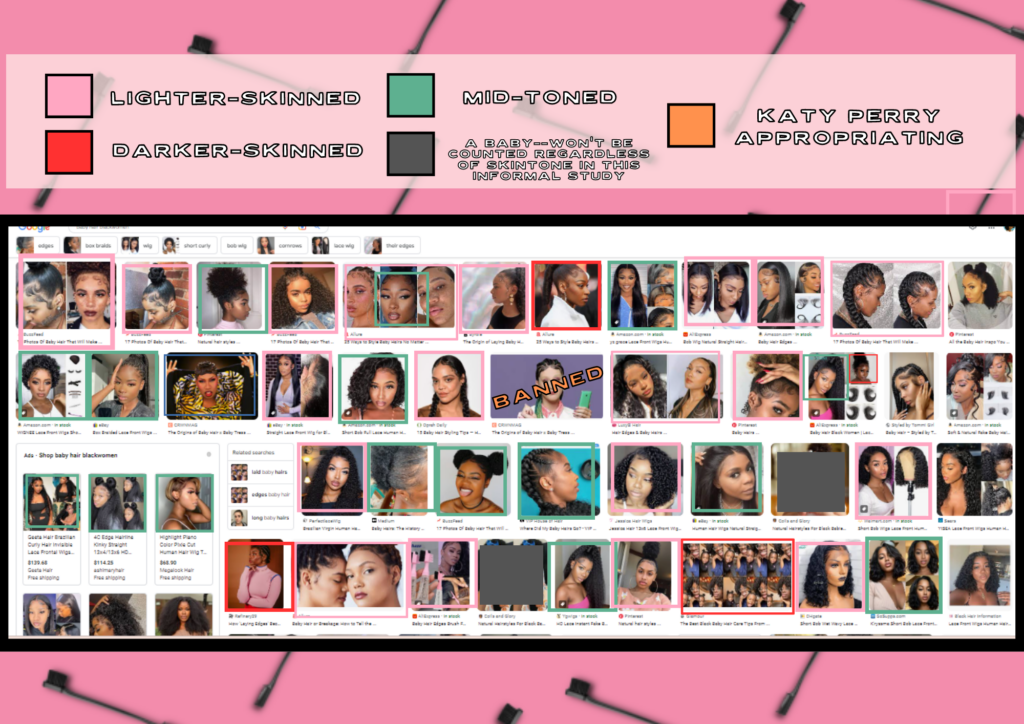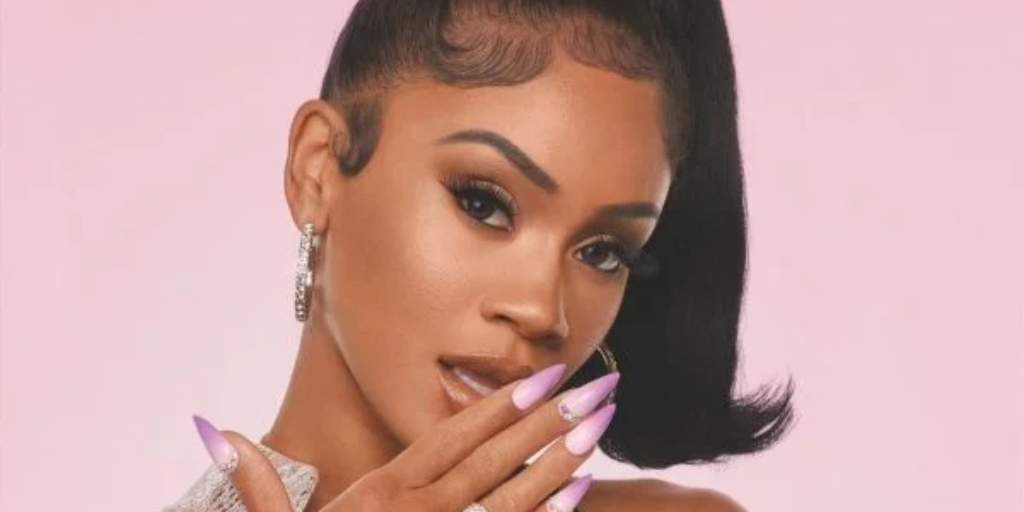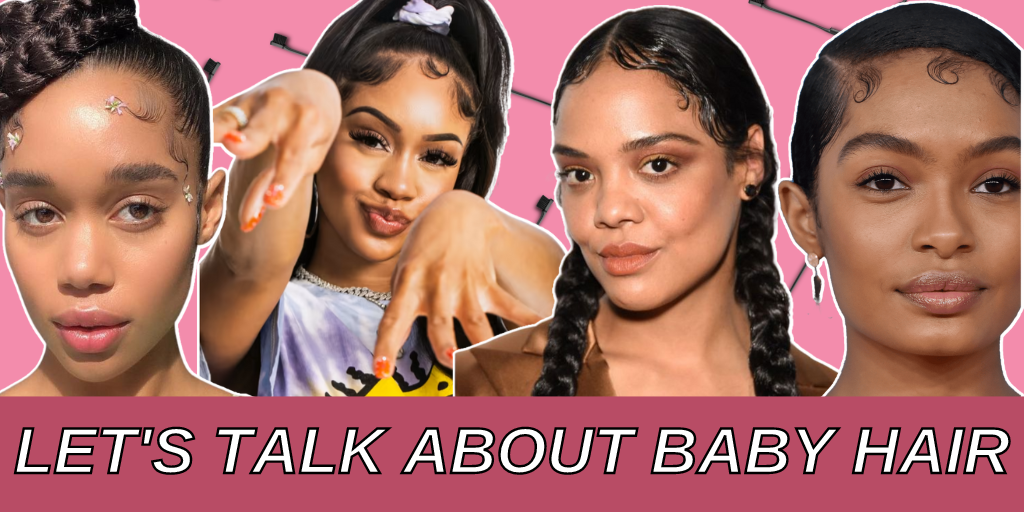Laura Harrier, Saweetie, Tessa Thompson and Yara Shahidi all rock baby hair. Also true: they are also considered beautiful for a wide range of reasons, including colorist and texturist reasons.
Writer’s note: I might use some entertainers as examples of colorism in the entertainment industry, but I’m not talking about their character or insinuating they consciously try to uphold colorism tenets. They are, however, examples of how the industry disproportionately gives lighter-skinned people more privileges than other Black women.
Baby hair has been part of Black street style for decades, but in recent years, it’s become a big fashion trend. Stars like Saweetie, Laura Harrier, Yara Shahidi, Zendaya and others have been styled with baby hair, and if you do a Google search of “baby hair,” more than likely you will see a majority of pictures showcasing lighter-skinned and mid-toned women, as shown later in the article. A question now presents itself–how much is the current baby hair trend resting on colorism?
Sometime last year, I saw a tweet by Tracee McMillan Cottom in which she asked her followers that very question. “Has anyone written the critical analysis on race, gender, class, colorism and our obsession with ‘baby hairs,’ yet??” she wrote. I saw this as a challenge, because I certainly saw a link between colorism and the focus on hair texture. So to analyze this, let’s take apart some of the big topics in Black hair politics and then seen how baby hair fits into the conversation.
“Good hair”
Explicit biases against Black features is part of the country’s DNA, and those biases extend to Black hair. Anti-bias research group the Perception Institute carried out a study regarding bias against Black hair. A topic that came up was the concept of “good hair.”
Good hair has been a concept in the Black community for decades, centered around how closely a Black person’s hair can resemble looser, straighter hair or be accepted by Eurocentric standards. As one of the participants in the Perception study wrote, good hair “means that a Black person has hair that is easy to come and style. The texture is naturally smooth and sometimes has a loose curl pattern. Easy to manage, maintain and style. Doe snot need a chemical or pressing to style.”
Another participant wrote, “When I hear the term good hair, I instantly thin kof racism, becuase people think that ‘good hair or nice hair’ means women with straight hair or women with hair flowing down your back. You don’t see women with afros or braids as ‘good hair.'”
Part of the results of the Perception study reinforced the fact that white people tend to see textured, kinkier hair as as unprofessional or less beautiful that straighter hair. While white women who identified as “naturalistas” (women who embrace their natural hair texture) viewed textured hair as more beautiful than other white women, white women overall rated textured hair at a 2.6 out of 5 when asked if they found textured hair “beautiful.” They gave it similar ratings when asked if textured hair is sexy/attractive or professional–the “sexy/attractive” rating was 2.5, while the “professional” rating was 2.3.
Black women rated textured hair higher, rating it 4.3 on the “beautiful” scale, 4.1 on the “sexy/attractive” scale and 3.4 on the “professional” scale.
While it’s expected that white women would have biases against textured hair, it is a slight shock that Black women also apparently have biases against textured hair too, particularly when it comes to Black hair in the workplace. But, while it might be a shock, it’s also not entirely surprising. If you’re a woman or femme who has grown up in Black households, you have have had conversations with other Black relatives in your family about how to wear your hair at work. If you’re applying for a job, your mom might tell you to straighten your hair so you can be taken seriously. Even if you wear a curl in your hair, that curl will probably have been put into blown-out hair to still maintain supposed “professionalism.”

The obsession with professionalism among other biases with textured hair comes from slavery itself. According to JSTOR, “[a]nti-Black hair sentiment on U.S. soil has existed for centuries. In the 1700s, enslaved women who worked in the fields usually covered their hair in head-rags due to the harsh demands of their work.”
“Enslaved Africans who worked in the ‘big house,’ however, sometimes mimicked the hairstyles of their enslavers, either by wearing wigs that had become popular during that era or shaping their kinky hair to emulate them,” the article continues. “In cities like New Orleans, however, where free Creole women of color donned elaborate hairstyles that displayed their kinks and coils with an air of regality the city implemented laws–the Tignon Laws–that required these women to wear a tignon (scarf or handkerchief) over their hair to signify that they were members of the slave class, regardless of whether they were free or enslaved.”
I also wrote about the Tignon Laws in my book, The Book of Awesome Black Americans. To quote myself, “Thinking of Blackness in terms of beauty has always been a radical, political act in this country ever since slavery embedded itself into the nation’s fabric…[T]here was a time when thinking a Black person was beautiful was potentially laughable. Case in point: the Tignon Laws, the set of rules enacted in New Orleans in the late 1700s that prohibited Black women from showing their hair.”
“As the Tignon Laws illustrate, people were very much aware of Black style, but to admit that a Black person was beautiful was controversial and even indecent. So, it comes as no surprise that the popular saying ‘Black is beautiful’ has been seen as a revolutionary statement in the past,” I wrote. “Instead, the statement should be interpreted as meaning Black people are just as beautiful as anyone else. A Black person can choose how they want to express themselves regardless of what others say. That’s the essence of ‘Black is beautiful.'”
Historically when it comes to Black hair, textured, kinky hair has been seen as “unprofessional,” “uncultured” or “less than” while looser hair has been seen as the exact opposite. Think about the Black female celebrities we know and love–it’s only been recently that we’ve seen Black actresses wear their natural hair texture, for instance Viola Davis, who has talked at length about embracing her hair and her darker skin. As she told Fashion Magazine in 2020 after she debuted her natural afro on the red carpet, “It goes back to hiding. It goes into erasure and invisibility and that has its birthplace in systemic racism.”
“It was projected in the culture that [the Black woman] wasn’t pretty, and the darker you were, the uglier wyou wre. And we carry that mentality [as Black women],” she continued. “We just carry it, even in unforeseen ways. That’s why I wore my natural hair.”
She also added later in the interview when talking about her natural hair in Widows that it didn’t occur to her that her natural hair was an option for her character.
“There’s something about connecting natural hair that’s kinky to ‘what’s not beautiful,’ she said. “And not only to what’s not beautiful, but that natural hair isn’t even in the conversation of beauty.”
When it comes to baby hair, it’s clear that “acceptable” baby hair isn’t kinky hair–it’s loose, thin, wavy hair. And, as Davis said, kinkier hair isn’t considered when it comes to what is considered “beautiful.” No one says they want kinky baby hair, do they?
The looser the hair, the closer to affluence and whiteness?
As The CROWN Bill states, according to Teen Vogue, “Professionalism was, and still is, closely linked to European features and mannerisms, which entials that those who do not naturally fall into Eurocentric norms must alter their appearances, sometimes drastically and permanently, in order to be deemed professional.”
The link between professionalism and Black hair plays into appearances of affluence. In order to be “accepted” into the white person’s world, you have to jump through hoops. And for Black women, some of those hoops are attached to a hair blower and heat straightener.
Teen Vogue cited various cases of Black people taking their experiences of hair discrimination to court, including the 1976 case Jenkins v. Blue Cross Mutual Hospital Insurance, which was found in favor of Beverly Jenkins who was told her afro wasn’t appropriate to represent the company. The court found that afros were protected under Title VII of the Civil Rights Act, making it a major instnace of kinky hair being protected under the law. Despite this, though, the hair of Black adults and children is still unofficially policed by employers, teachers, and anyone else with authority in the corporate or education fields.
The feeling that Black hair can be policed is rooted in the same idea that Black skintones can be policed. As The Black Story states, “Colorism, differential treatmen tbased on skin colour, has a pair of nasty cousins just as problematic–Featurism & Texturism.” Featurism is described as “society accpetain or preferring certain features [usually Eurocentric features] over others.” Texturism means “a preference for hair with smoother/looser texture, and the discrimination against people with kinkier, coarse hair within the same race.”
“The racist roots of colorism are a product of the idea that white people and their white skin are superior,” the site continues. “The closer you look to white people, the more preferred you tend to be. And it’s much more than the light skin that gives you the privilege; it’s any feature that applies to society’s perception of ‘beauty.’ You can have light skin, but you must also need the specific type of hair and physical features to accompany the skin in order to be considered ‘beautiful.’

Texturism’s racist roots run deep. According to Forbes, “hair typing was a system used to understand an individual’s ‘proximity to whiteness based on their [hair] texture.'”
“The original hair type categoriazation system was developed in the early 1900s by Eugen Fischer, a Nazi German scientist and ardent eugenicist,” continued the article. “Fischer used this system in present-day Namibia on the mixed-race population to try and determine ‘Blackness’ based on hair texture.” The article states that Namibia faced a mass genocide carried out by Germany between 1904 and 1907, resulting in 80,000 of the Namibian people being killed. The genocide was based entirely on racial supremacy, including the hair typing system created by Fisher.
The hair typing system we use today (using numbers and letters, like 1B, 4C, etc) is usually credited to Andre Waller, Oprah Winfrey’s hairstylist, even with a Black face, the hair typing system still ends up replicating supremacist practices and beliefs. 4C hair is the kinkiest hair texture, and as you might have seen on YouTube when searching Black hair vloggers, 4C is usually the hair type least shown, whereas looser hair types are seen as more marketable and aspirational.
We’ve seen examples of colorism and texturism in Hollywood, starting in the Golden Age. The Black stars who were able to cross over–Dorothy Dandridge, Lena Horne and Fredi Washington, to name a few–were talented, of course. But being lighter-skinned, having Eurocentric features and having looser-textured hair also helped them appear marketable to Hollywood execs. Other actresses, like Hattie McDaniel, Juanita Moore and Butterfly McQueen, were billed as either comic relief or played “the help” parts because of their darker skin, broader features, coarser hair, and in some cases, their weight. For many like McDaniel in particular, playing “Mammy” roles were all they were given because of colorism, texturism and featurism–all of which help racism complete its goal.
Colorism, texturism, and featurism has continued throughout Hollywood, with actresses like Halle Berry, Lynn, Vanessa Williams, Lisa Bonet, and others benefitting indirectly from Hollywood’s focus on lightness, Eurocentric features and looser hair texture. Other actresses who might be a skin range from tan to mid-toned–think Lynn Whitfield, Tatyana Ali, Sanaa Lathan, and Nia Long, for example–were also able to benefit loosely from not being darker-skinned, as well as having looser hair (whether that came naturally or from styling) and features that either skewed more towards Eurocentric ideals or, in the case of Ali and other Black actresses of the time who were biracial or multiracial, features that Hollywood would read as “exotic.” During the ’90s, Whoopi Goldberg, Gabrielle Union and Angela Bassett were two of the darkest actresses I remember seeing growing up.
Even in television shows and film, colorism, texturism and featurism was part of comedic punchlines or even drama. The comedy Martin, for instance, doesn’t hold up when it comes to how darker-skinned women were treated. Even though Gina (Tisha Campbell) and Pam (Tichina Arnold) were best friends, Gina was seen as the aspirational one in part to her lighter skin and straighter hair. She was Martin’s (Martin Lawrence) girlfriend after all. Pam, on the other hand, was often the butt of the jokes Martin would make, and Pam was often getting into it with another Black female character, Shanaenae (Lawrence), who is herself a negative caricature of a dark-skinned Black woman. Ditto for Wanda, one of Jamie Foxx’s characters on In Living Color. Even though these two characters are funny, more people are rightly dissecting the impacts these characters could have had the psyches on young darker-skinned Black girls at the time.
Now what about baby hair?

So what does this have to do with baby hair? It’s important to know all of the background in order to understand how baby hair was popularized in part because Black girls and women with kinkier hair wanted to make their edges look less kinky.
“For those of us with tighter curl patterns, slicking down baby hair became a method of ‘looking presentable,’ wrote Crwnmag. “The waves we created along our foreheads with a toothbrush and styling gel mimicked the wispy waves found along the crowns of women with finer textures that were considered more acceptable. Generations of women became conditioned to the belief that your [hair] was not done until your baby hairs were laid. The second coming of the natural hair movement in the mid-2000’s led to conversations against the idea that Black women with tightly textured curls need to ‘tame’ their edges at all.”
Indeed, that conversation is continuing–an example is a 2018 article from Buzzfeed called “Just A Friendly PSA That You Don’t HAVE To Lay Your Edges Down If You Don’t Wanna.”
“No shade to the ICONIC toothbrush + edge control combo, cuz they’ve held us down since forever…[b]ut edges can ALSO be lush and textured, like this heavenly puff…[o]r free and effortless…[a]nd that’s A-OK! BTW, having unlaid edges doesn’t mean your hair’s dry. Nor does it mean youre hair’s not ‘done.’ …Long story, short: unlaid edges are just as acceptable as laid ones.”
With so much of Black women’s livelihoods once depending on baby hair as proof of acceptability and worth, my hope is that the conversation can keep getting stronger. Indeed, there are many women, regrdless of skintone or hair texture, who love baby hair, but I hope as we progress, baby hair can be honestly examined for its complex history and maybe, in some cases, retired from some people’s repertoire the more they come to love their own textured edges. There is nothing wrong with your hair texture, just like how there’s nothing wrong with your skin tone or facial features. What makes you different is what makes you unique, and uniqueness should always be embraced.
If you would like to read more of my book, The Book of Awesome Black Americans, buy a copy at Amazon.
